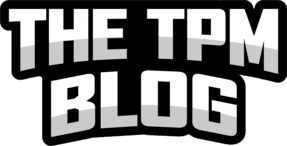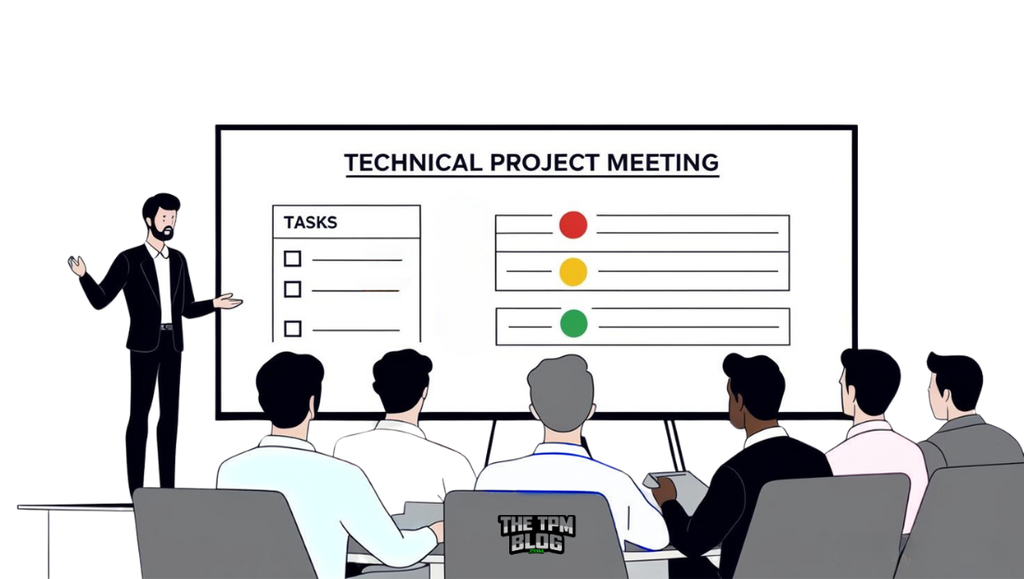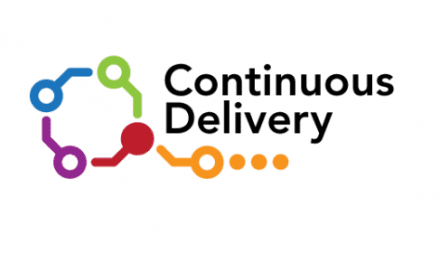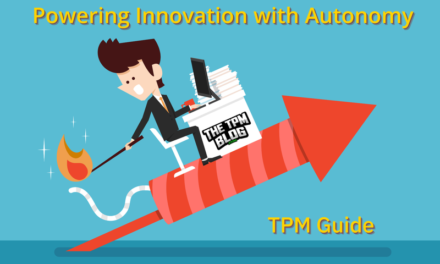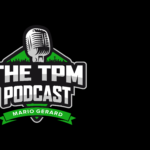Last updated on January 16th, 2025 at 02:26 am
Reporting program status effectively and transparently is one of the most critical things to get right in a program to ensure clear communication with stakeholders, leadership, and cross-functional teams. It provides visibility into the health of a program, highlighting risks, progress, and roadblocks. This is how TPMs drive informed decision-making, maintain alignment across teams, and build trust in their ability to manage complex programs. It also allows TPMs to proactively address issues before they escalate, keeping projects on track and leadership confident in the TPM’s oversight.
You can use it to get the support you need and ensure that no one on the team or management chain is taken by surprise. It inspires trust and transparency through all levels and functions in the organization when everyone understands the criteria and trusts the TPM to report status accurately.
TPMs often hesitate to turn a project status to red for several reasons. They might fear blame or that it reflects poorly on their performance. Red status can be perceived as a sign of failure, and TPMs may fear it will impact their reputation or career trajectory. There is often pressure from leadership or stakeholders to keep projects on track, and marking it red may feel like admitting defeat. A TPM may believe that challenges can still be resolved quickly and avoid marking it red, hoping issues will resolve without alarming stakeholders. Marking a project as red often triggers escalations, meetings, and higher scrutiny, which some TPMs may want to avoid. Despite the hesitation, turning a project red when warranted is important for transparency and for getting the help needed to address issues effectively.
RAG Methodology
The most common and simple method used is RAG – Red, Amber(Yellow), Green. It visually communicates project status in a concise way, it is data driven. I have seen many TPMs and organizations hesitating to turn a program Red till the absolute last moment when they reach a point of no return. However, when used consistently and with clear definitions, this method can be a game-changer.
Pros of the RAG Method:
- Simplicity: The RAG (Red, Amber, Green) method offers a straightforward, visual way to quickly assess the health of a project or program. It’s easy for all stakeholders to understand, regardless of their technical background.
- Quick Insight: It provides a quick snapshot of progress, helping leadership and stakeholders gauge overall status at a glance without diving into the details.
- Clear Focus: Red, yellow, and green indicators clearly highlight where attention is needed. It’s easy to see which areas are on track and which need urgent action.
- Structured Updates: The method encourages regular, structured status updates, ensuring consistent communication across teams and leadership.
- Prioritization: Helps in prioritizing efforts, as red status immediately signals critical issues that need resolution.
Cons of the RAG Method
- Oversimplification: The method may oversimplify complex project dynamics. A red, yellow, or green label doesn’t always capture the nuances of why a project is in a certain state or what the underlying issues are.
- Subjectivity: Without clear guidelines, the criteria for what qualifies as red, yellow, or green can be subjective and vary from person to person, leading to inconsistent reporting.
- Hesitation to Report Red: As mentioned earlier, TPMs may hesitate to turn a project red due to fear of repercussions, delaying necessary escalations and support.
- Lack of Detail: The RAG status alone doesn’t provide context or actionable insights. Additional explanation is often needed to understand the root causes and next steps.
- False Security: A green status may provide false reassurance, as it can mask underlying risks or emerging issues that haven’t yet impacted progress but could in the future.
- Binary Approach: The method doesn’t always accommodate the complexities of project work, where certain parts of a project may be red while others are green, making it difficult to represent the full picture.
Despite its limitations, the RAG method remains popular because of its simplicity and effectiveness in providing quick, high-level updates. However, it’s best used in combination with deeper context and explanations.
This is my recommendation on the definitions of status and how to consistently use them to build trust, drive actions, accountability and keep leadership informed.
Assumptions
- You must have a project plan in place with high level milestones well defined so that you are constantly working backwards from your projected end date.
- High level milestones must include any critical delivery dates by dependencies or partners.
- The program must have a projected end date that has already been agreed upon by stakeholders. This could be the need-by date to unlock or launch a new feature for customers, remedy a system issue or replace an older system etc. It is closely tied to why the program exists and adds value.
Project Status Definitions
Green: Project is on track, no critical risks exist that do not have a mitigation strategy.
Amber/Yellow: Project is currently on track, however there exists one or more critical risks for which there is not yet a mitigation but there are feasible options that are being pursued (Path to Green) to keep the milestone on track. There is also a date provided, by which critical risks will need to be mitigated or have an action plan, else the project is at risk of turning Red.
Red: Project is not on track and there will need to be changes to milestone/program schedule, scope, resourcing and intervention to help prioritize the project needs. There is currently no Path To Green to maintain the original promise. Any reset to promised milestone dates should cause the program to turn Red.
Path To Green(PTG): This is the concept that most TPMs miss out on and is the defining variable in running programs successfully. You must always, without doubt, know whether or not there is a PTG.
Rules to follow:
- IF a project has a roadblock that could impact its projected end date or a high level milestone, and no ETA(date) by when it will be resolved, then the project must turn Red until a mitigation or alternative is established.
- Yellow means there is a path to green. If there is no path to green, then the program is Red. There is no debate here. It could turn green again, but for now it is Red with an explanation on what needs to change for PTG or a date by which a PTG will be established.
- Ideally a project must not move directly from Green to Red if it is being monitored closely. It can happen in rare cases, eg: when there is a top down prioritization change.
Common Pitfalls
Common pitfalls for TPMs when reporting status include:
- Lack of Clarity: Using vague or overly technical language that confuses stakeholders rather than informs them.
- Overloading with Details: Sharing too much information, overwhelming leadership with unnecessary data instead of focusing on key points.
- Inconsistent Updates: Failing to report regularly or updating with inconsistent metrics, leading to confusion or lack of trust in the reporting.
- Ignoring Risks: Downplaying or omitting risks and challenges, which can create surprises later and erode credibility.
- One-Size-Fits-All Reporting: Not tailoring the status report to the audience—technical teams may need details, while executives want high-level summaries.
- Reactive Reporting: Waiting until problems arise to update status, rather than proactively signaling potential issues early.
- Subjective Assessments: Using unclear criteria for Red, Yellow, and Green statuses, which can lead to misinterpretations and lack of action.
Tips for TPMs
Sometimes, TPMs have to influence and set the tone for organizational culture around status reporting. This is how TPMs add value by instituting cross-functional transparent processes across levels in the entire organization.Even if these processes exist, they still need adherence and enforcement to be effective.
Remove the stigma of turning Red – Red means there is a risk that will require hard trade-offs on program scope, resourcing, budget or schedule that could have subsequent impacts. It will mean a change that will need approval or support to mitigate the risk.
Try(your best) to never turn Red – Confused? Read on! You should never let your program turn Red if you can help it. That is your sole guiding principle as a TPM and what you are there for. However, it almost invariably happens to most projects at some point. What I mean by try to never let your program turn red is – you should have exhausted all options to resolve the roadblocks that are within the program team’s scope of control, including escalating to senior leadership for support on alternates before letting the Program turn Red and re-negotiate one of the committed program deliverables(Schedule, Scope, Budget, Quality). I recommend you do not compromise on Quality, though you might move things around in terms of pre vs post quality activities based on risk exposure. However, I have always found that compromising on quality leads to bigger risk downstream and tends to be short sighted.
Do not be a watermelon – green on the outside and red inside.
Make sure to recognize any significant achievements since the last status report. Celebrate anything that exceeds expectation.
Caveats – Sometimes a late breaking issue can cause a program to turn Red where there is not enough time to discuss alternatives and explore them. That is fine, include that in the explanation of why the program is red and a date for a date where you will have more information. Commit to an offline update as soon as the team is able to convene on some options so that critical stakeholders and executive sponsors are not waiting on the next program review for an update. Keep everyone informed as events warrant and boas for action.
Ready to level up your TPM Career?
Unlock your potential as a TPM—master the fundamentals, navigate career levels, and excel in your role.
Author

Preetha Annamalai
Preetha Annamalai is an ex-Amazon Senior Manager who has led cross-functional software, TPM, and product teams. She has 18+ years of experience driving strategic initiatives and fostering innovation. Preetha excels at building high-performance teams and guiding professionals to reach their full potential.
